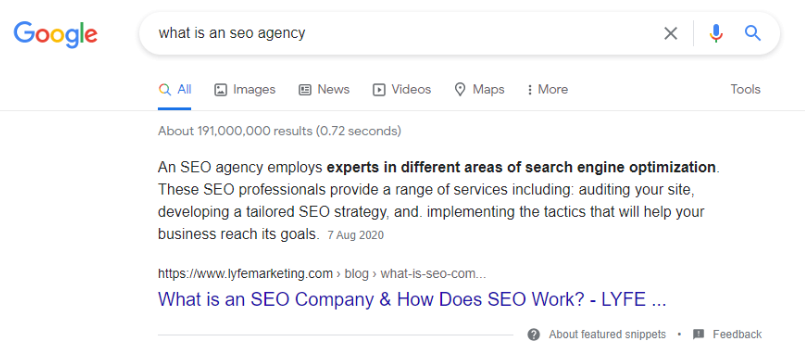What is a long tail keyword?
A long-tail keyword is considered to be at least three words and generally has a lower search volume but captures a higher user intent. They are higher intent because, with more words, a user can be more descriptive about what they are searching for. Collectively, these specific searches don’t make up a large monthly search volume, but they do make up most searches entered into search engines.

Long tail queries are often conversational
User queries are becoming increasingly conversational and thus longer, and Google is getting smarter and better at understanding and serving more relevant results that answer these conversational queries. This was properly refined with Google’s Hummingbird update in 2013.
By using natural language processing, Google has improved its conversational and semantic search capabilities. This will need to be factored into the tone of your content when targeting long-tail queries and is particularly important for voice search (more on that later).

Long tail keywords vs short tail keywords
Short-tail keywords are usually the ones that clients want to focus on and get excited about, as they have the potential to drive a high volume of traffic. However, they generally take a long time to rank. They are often the keywords everyone wants to rank in position 1 for (making them highly competitive and sometimes unrealistic keyword targets depending on site authority). Conversely, long tail keywords drive a lower level of traffic; however, that traffic is comparatively more convertible. They also tend to be lower in competition and thus easier to rank for.
Furthermore, being able to rank for longer tail variations of a short tail keyword helps you rank for the short tail version of the keyword itself over time, as you have proven to search engines that your site has authority for the overall topic. This is a particularly useful strategy for smaller sites which are competing for competitive keywords, for which well-established brands typically rank. As an agency specialising in creating holistic SEO content strategies, we like to incorporate a mix of both to help our clients drive both awareness and conversions via organic search.
Keyword examples: A Cookie case study
Let’s take the topic of ‘cookie recipe’ as an example for this exercise (Can you guess what food I’m craving? P.S. If you’re looking for food & bar recommendations, check out my curated Sydney food & bar guides). Natalie, a talented cookie chef, has been wanting to release her famous cookie recipe online and would like to generate traffic to this recipe via organic search. What keywords should she be targeting on her site?
On its own, the short tail keyword ‘cookie recipe’ has 27,100 average searches a month in Australia. That’s a lot of searches for cookies every month! When we look at which sites are ranking in the top 3 positions, we can see well-established recipe sites like taste.com.au among the mix. Unfortunately, Natalie’s hobby site is most likely not going to outrank this website.
Luckily, many longer tail keyword variations feature ‘cookie recipe’, which could be worth targeting. Here are some examples of some promising keywords to target & why.
| Keyword | Average monthly search volume (AU) | Why it's a good keyword target |
|---|---|---|
| Chocolate chip cookie recipe | 9,900 | Will address the search intent of users wanting to create a chocolate chip cookie as opposed to a white chocolate cookie |
| Cookie recipe healthy | 1,900 | Will address the search intent of users looking for a healthy alternative rather than one that is high in saturated fat and sugar |
| Edible cookie dough recipe | 1,900 | Will address the search intent of users looking to create cookie dough rather than overn baked cookies |
| Cookie recipe basic | 1,600 | Will address the search intent of users looking for a simple cookie recipe who are time poor rather than one recipe with too many steps |
As you can see, the specific examples in the table above are a better keyword target than ‘cookie recipe’ because it addresses a more specific search intent. Therefore, Natalie should do some research around queries which have a more particular intent around ‘cookie recipes’ and target the ones that align with her product.
How to conduct long-tail keyword research
Many platforms allow you to identify long-tail keyword variations of short-tail keywords. No matter which platform you’re utilising, you want to start with a short-tail keyword (or the topic name) and filter the data set by:
- Word count above 3
- Low keyword difficulty/competition
- Low search volume – a ‘low’ number will depend on how large the search volume is for the head term
Useful keyword research tools
At Indago Digital, our SEO experts have tried and tested the tools below to identify long-tail keywords. Our favourites include:
- Keyword Tool by keywordtool.io
- Keyword Explorer tool by Ahrefs
- Keyword Magic Tool by SEMRUSH
Outside of using tools, another great place to spot long tail keywords is via the ‘related searches’ section at the bottom of Google’s Search results pages. Google’s algorithm automatically generates these to determine terms related to your search. They are instrumental in helping you understand what information your potential customers are seeking and, thus, tell you what questions you should answer. Enter your short tail keyword and scroll to the bottom: boom, gold mine.

Long tail keyword strategy
Now that you have a set of high-intent keywords – where do you feature them on your site?
First, you must determine the intent of these keywords and whether you have a page on your site that serves this intent. If the answer is yes, then you can feature these long-tail keywords as subheadings on existing pages or within the body copy of the page. If the answer is no, I’d recommend creating a new landing page to capture this search intent.
Blog strategy
Another strategy that I�’ve utilised, which works very well in driving traffic via non-purchase intent keywords, is creating a large number of blog pages targeting long tail keywords of a particular topic (as opposed to creating a single page answering all these questions). This is because they have a lower keyword difficulty score, making it easier and quicker to rank in click-driving positions. Don’t forget to include internal links from these pages to related product pages and other related blog articles!
Optimising for voice search using long-tail keywords
According to a 2021 white paper study by B&T, 57% of Aussies are now using voice search, meaning that it should be on the radar of your SEO team or agency. Voice search queries are conversational and naturally long tail, and it is worthwhile noting that almost 40.7% of voice search answers originate from a Featured Snippet result. Therefore, you can kill two birds with one stone if you know what queries to target!
A great way to rank for voice search and featured snippet positions is by targeting question-based keywords, as these will more often pull in a featured snippet result. According to this SEMrush study on featured snippets, 77.63% of ‘why’ queries and 65.27% of ‘how’ questions will trigger these.
This makes sense if you think about it, as people will be speaking to their voice assistant in the form of a question. To increase your chances of ranking for a featured snippet and being selected for voice search answer, I’d recommend including the question at the top of the page and answering it with a 40-60 word summary, as this is what Google will likely display within the featured snippet box.

Real life example: Lyfe Marketing has created a dedicated page answering the question featured as a long tail query, ‘what is an seo agency’. Effectively answering this question has enabled the site to rank within the featured snippet position, which provides additional visibility for the search result and improves brand awareness.

Conclusion
Why use long-tail keywords for SEO?
If you’ve read this far, you will understand the importance of these low-volume queries. To summarise, here are the top reasons why long-tail keywords should be featured in every SEO strategy:
- High intent, therefore highly convertible
- Can support the ability to rank for a short tail keyword
- Conversational in nature, helping rank for voice queries
- Low volume, therefore, low barriers to ranking in click-driving positions and drivings traffic when a long tail strategy is used at scale
Written by
Chloe Zheng





